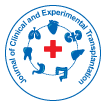Induction Therapy: Comparison between Poly and Monoclonal Antibodies
Received: 05-Nov-2017 / Accepted Date: 14-Nov-2017 / Published Date: 21-Nov-2017 DOI: 10.4172/2475-7640.1000118
Abstract
Objective: Compare the effects of 2 molecules as induction treatment in renal transplantation (RT): polyclonal antibodies (rATG or thymoglobulin) versus a monoclonal antibody antagonist of interleukin 2 receptors (basiliximub) in terms of occurrence of episodes of rejection, delayed graft function, graft loss, and the occurrence of infectious and neoplastic complications.
Patients and methods: A retrospective study involving 191 patients transplanted from 2007 to 2016 with a minimum follow-up of 3 months at department of nephrology, dialysis and transplantation Sahloul Sousse Tunisia. The induction treatment consists of the administration of a monoclonal antibody for 67 patients group 1 (G1) and polyclonal antibodies (anti-thymocyte anti-thymocyte globulin or thymoglobulin) for 124 patients group 2 (G2). In maintenance, patients were treated with ciclosporin or tacrolimus combined with MMF and corticosteroids or MMF alone with corticosteroids.
Results: We included 191 transplant patients with mean age of 33.13 ± 13.04 years. The occurrence of episodes of rejection was more frequent in patients treated with rATG (21.77% in G2 versus 14.92% in G1) but without significant difference (p =0.253). The delay of occurrence of rejection was shorter in the G1. The uni-varied study showed that the occurrence of pneumopathies (p=0.005, OR=6.626, IC [1.503-29.20]), urinary tract infections (p=0.020, OR=2.044, CI [1.115-3.748]), cystitis (p=0.038, OR=1.918, CI [1.032-3.564]), CMV infections (p=0.04, OR=2.567, CI [0.996-6.615]) and digestive infections (p=0.035, OR=4.472, CI [0.991-20.186]) are significantly observed with rATG treatment. In multi-variate analysis only pneumopathies (p=0.014, CI [0.034-0.681]) and urinary tract infections (p=0.04, CI [0.277- 0.969]) were significantly frequent with ATG treatment. Neoplastic complications occurred exclusively in G2. We found no significant difference for delayed graft function and graft loss in both groups.
Keywords: Renal transplantation; Monoclonal antibody; Induction therapy
Introduction
Admittedly, immunosuppressive induction therapy in renal transplantation (RT) has proved its place in the prevention of graft rejection, especially in patients at high immunological risk [1]. Several molecules have been put on the market. They act by different mechanisms. These molecules are generally antibodies that can target a single well-defined antigen (monoclonal antibody) or several antigens (polyclonal antibodies) whose role in the development of the rejection process has been well demonstrated.
Polyc
